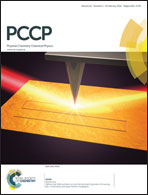Photophysics of a Schiff base: theoretical exploration of the excited-state deactivation mechanisms of N-salicilydenemethylfurylamine (SMFA)†
Abstract
Excited state reaction coordinates and the consequent energy profiles of a new Schiff base, N-salicilydenemethylfurylamine (SMFA), have been investigated with the CC2 method, which is a simplified version of singles-and-doubles coupled cluster theory. The potential energy profiles of the ground and the lowest excited singlet state are calculated. In contrast to the ground state, the excited state potential energy profile shows a barrier-less dissociation pattern along the O–H stretching coordinate which verifies the proton transfer reaction at the S1 (ππ*) state. The calculations indicate two S1/S0 conical intersections (CIs) which provide non-adiabatic gates for radiation-less decay to the ground state. At the CIs, two barrier-free reaction coordinates direct the excited system to the ground state of enol-type minimum. According to calculation results, a trans-keto type structure obtained from photoexcitation of the enol, can be responsible for the photochromoic effect of SMFA. Furthermore, our results confirm the suggestion that aromatic Schiff bases are potential candidates for optically driven molecular switches.


 Please wait while we load your content...
Please wait while we load your content...